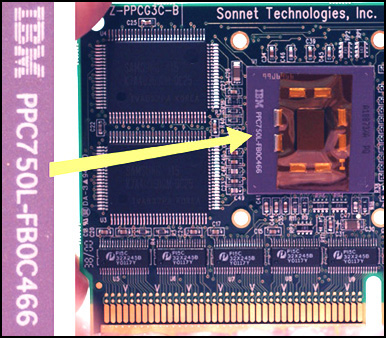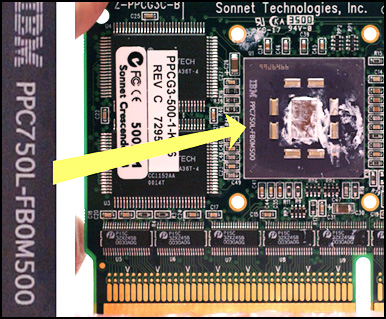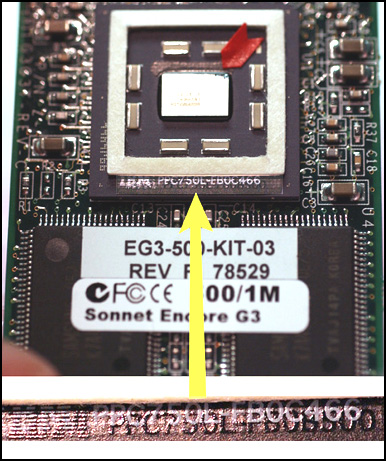| ID | | Article Title | Post Date |
|
72 | 
| The Crescendo/Encore installer hangs, or crashes the system; occurs most often when run from the Sonnet installer CD. | May-12-09 |
|
171 | 
| The speed indicated on the G3 or G4 chip on my Sonnet processor upgrade doesn't seem to match the speed of the upgrade I purchased. What's the story? | May-07-09 |
| Sonnet sells and guarantees reliable products, as we have for over 20 years. We are always conservative with our customers' machines, and with how we select processors for our many upgrade products. We select processors based on the intended operating environment. Different applications have different cooling systems (heat sinks, fans, etc.), different airflow and different operating temperatures. Every chip has an operating space based on three parameters: speed, heat and voltage. The relationships between these parameters are well known by the chip manufacturers, and are communicated to OEM customers like Sonnet. A few examples are below.
Note: Despite the inclination to do so, you should never remove the heat sink from a Sonnet upgrade card. Breaking the thermal seal can result in erratic and unreliable performance if the seal is not perfectly re-established. In addition, Sonnet heat sinks are screwed down with a specific sequence and controlled torque. If this is not done correctly, it can result in a warped card, or even a cracked processor die. For these reasons, Sonnet's warranty is void if the heat sink has been removed.
Example 1: Desktop Macintosh solutions.
Apple specifies its current desktop models to operate at ambient temperatures up to 35 degrees Centigrade (95 degrees Fahrenheit). A G3 processor (with heat sink and airflow in these desktop systems) runs about 10 degrees C higher than ambient, so the resulting processor chip must run reliably at 35 + 10 = 45 degrees C.
Sonnet is conservative in all of its chip selections, and specifies processor operation to 65 degrees C. To ensure reliable supply, we qualify any appropriate available parts from the manufacturers that will operate in this environment. Processors have an inverse linear relationship between operating temperature and speed with a factor of 0.85 MHz per degree Celsius. In the case of a 500 MHz G3 Crescendo card, we have qualified two processors. One is a 65\u172\u8734 C G3 500 (designated by an "A" in front of the 500 in the part number), and the other is a 105\u172\u8734 C G3 466 (by a "C" before the 466). 466Mhz + (105\u172\u8734 C-65\u172\u8734 C) x 0.85MHz\u172\u8734 C = 500MHz at 65\u172\u8734 C. There is no compromise in chip life, reliability or performance, and except for the number stamped on top, there is no difference between these chips.
Why are chips marked differently? The makers need to supply solutions for different markets. Identical chips can be marked differently for commercial and industrial markets. When a part is incorrectly forecast, or if a customer cancels an order, the parts built for them may be offered to other markets. Sonnet qualifies and understands these alternate markings to allow quick use in the event that there are part delays, or if special purchase opportunities become available. Sonnet qualifies parts by stress-testing our products under extreme conditions. This allows us to offer reliable solutions with better part availability and often at lower prices.
In some cases, a chip manufacturer marks chips for one market and later overprints a different part number based on shifting market demand. Below are pictures of three equivalent parts with markings that illustrate the issue discussed above. The first is marked C466 (for 466 MHz @ 105\u172\u8734 C), the second is marked M500 (500 MHz @ 65\u172\u8734 C; "M" is a special symbol for a specific vertical market), and the third clearly shows a B500 (85\u172\u8734 C 500 MHz) part remarked as a C466. This clearly shows that the manufacturers trade off heat for speed on the same part.

Sample 1: Marked C466 (for 466 MHz @ 105\u172\u8734 C)

Sample 2: Marked M500 (500 MHz @ 65\u172\u8734 C)

Sample 3: Shows a B500 (85\u172\u8734 C 500 MHz) part remarked as a C466
Key Point: Because these parts are identical except for their markings, there is no compromise in reliability or product life.
Example 2: PowerBooks
PowerBooks have higher internal operating temperatures than desktop Macs, therefore Sonnet must provide extra margin to ensure reliable operation. On these models, Sonnet has qualified a 500 MHz "B" part (rated at 85\u172\u8734 C), and a 533 MHz "A" part (rated at 65\u172\u8734 C). In this case, chips may actually carry a speed marking that is higher than the speed of the Sonnet product to which they are attached! The speed marking alone is not enough. A G3 processors marked at 500 MHz, but rated at only 65\u172\u8734 C would be insufficient for reliable operation in a PowerBook.
Key Point: Sonnet selects parts based on their engineering specifications and their ability to perform as advertised, with generous margins. We do not take chances with our customers' machines.
Related Issue: In some cases, products of one specification may be stamped with an entirely different part number. At times, chip manufacturers have contracts to supply low-speed parts for extended periods, even after it is no longer cost effective to continue making the relatively slow parts. It is common practice in these cases to place the obsolete part's marking on a higher-speed part to fill the contract and to avoid any pricing conflicts in the market. In some rare cases, the parts marked for these sales become available to other customers, and if the tested specification is communicated and confirmed through testing, then we may use them in appropriate applications.
Example 3: Crescendo/PPC G3 450 1M
Some of these products have been reported to carry 333MHz processors. This is not correct. These parts are 85\u172\u8734 C 450MHz processors (designated by a "B"). They were remarked as 333MHz for a low-end customer that did not take them all. Sonnet purchased them with the information provided by the manufacturer that they were 450MHz processors. Sonnet waived the time and expense associated with remarking them again as 450MHz. On close inspection, the original part number can be seen, screened over on the surface of the chip. The photograph below clearly shows the over-stamp and the fully readable original tested marking covered beneath. |
| |
|
218 | 
| The computer's standard startup process takes noticeably longer after upgrading to any Mac OS 9.x system from Mac OS 8.6 or earlier. | May-12-09 |
| |